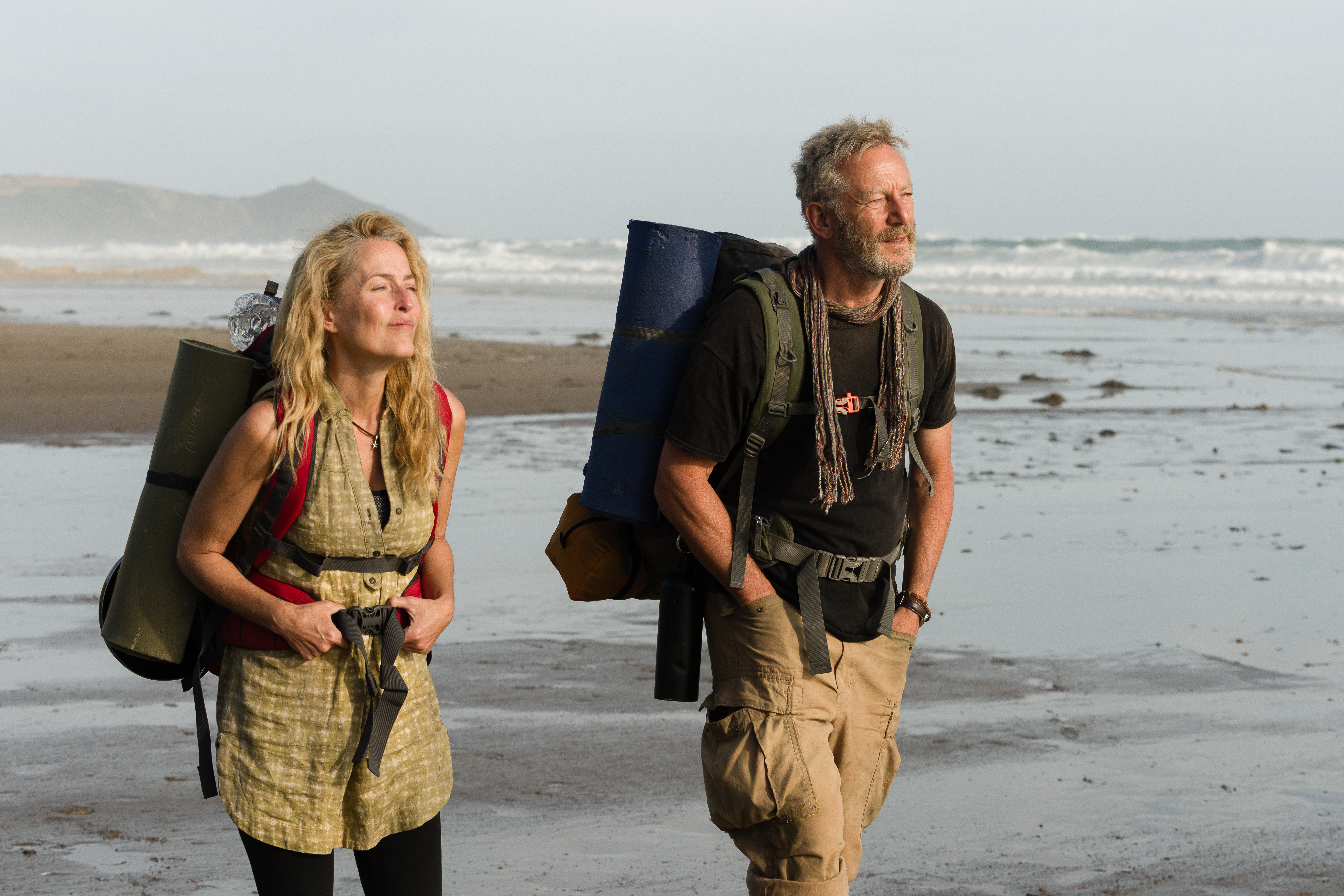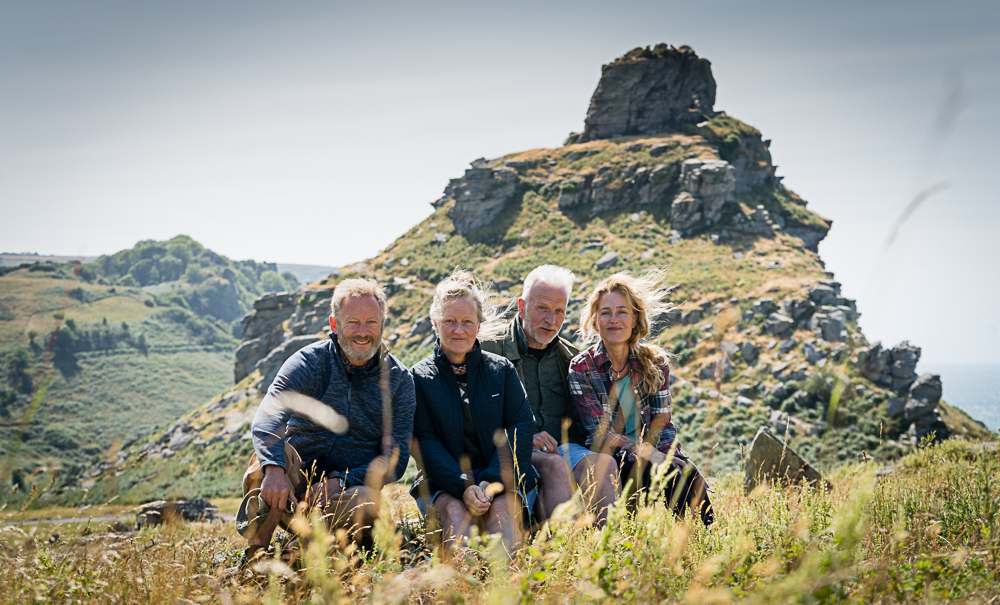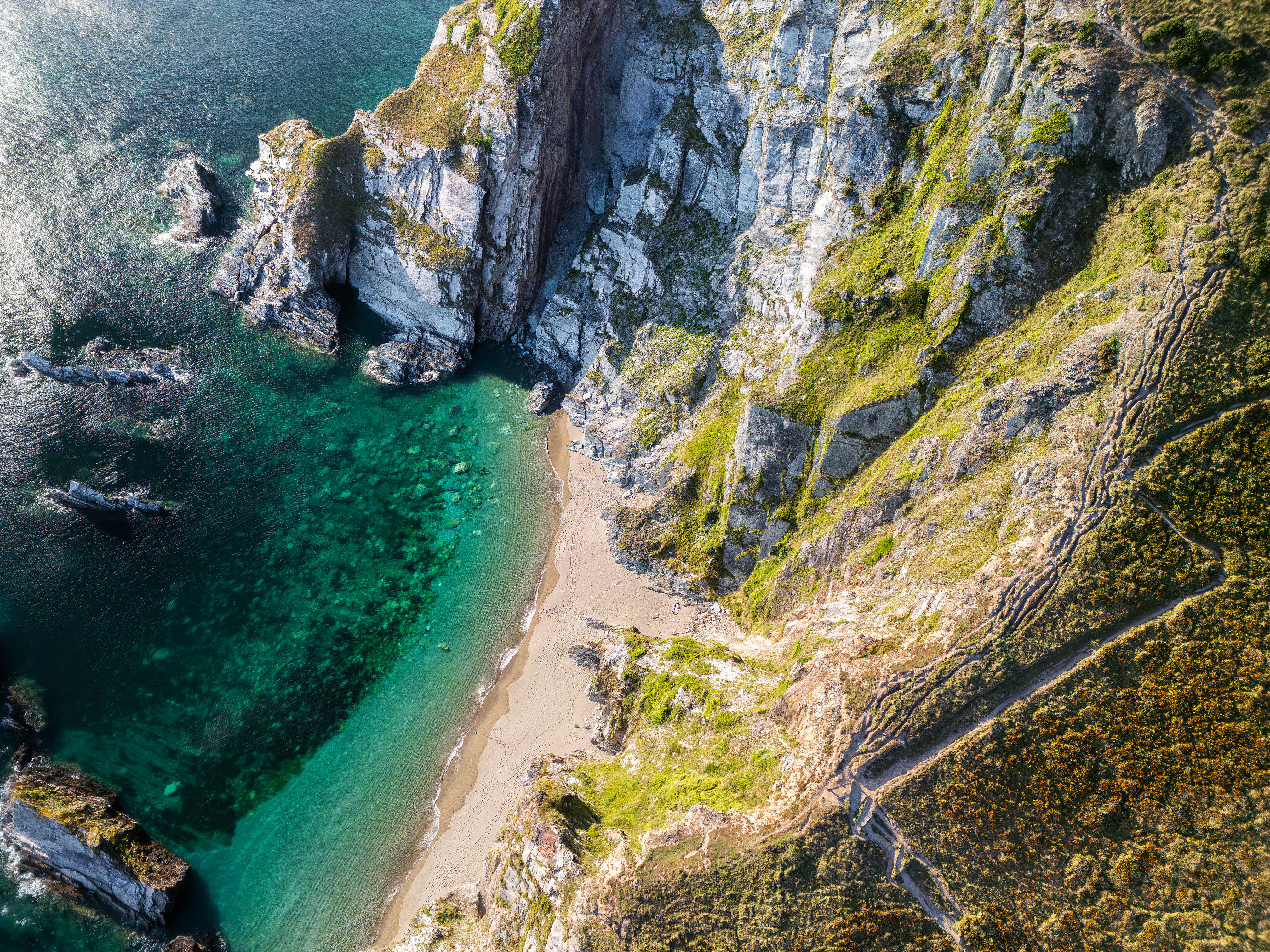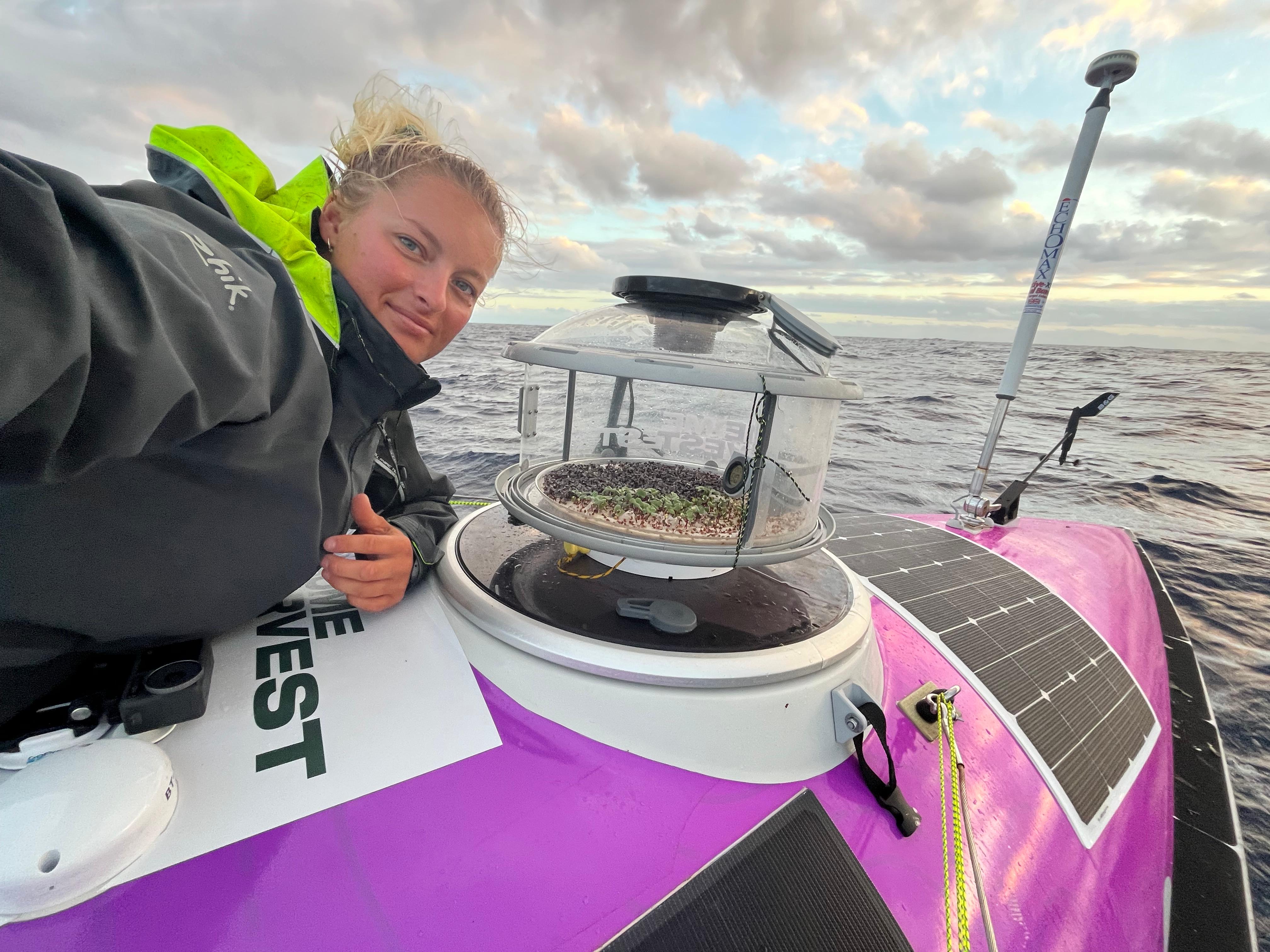The Salt Path: The 630-mile trail that saved one couple’s life and inspired Britain to lace up its walking shoes
Raynor and Moth Winn were homeless and battling terminal illness when they made the decision to walk the South West Coast Path — and now Raynor’s best-selling book has been adapted for the big screen.


Imagine climbing Mount Everest four times. That’s what walking the South West Coast Path (SWCP) is equivalent to. It is not then, you would think, a great idea for someone who has been diagnosed with Corticobasal Degeneration (CBD) — a rare terminal illness — but it didn’t faze Moth Winn, supported, both emotionally and physically, by his wife, Raynor.
The author’s account of her and her husband’s journey along the 630-mile walking route was an instant Sunday Times bestseller when it was first released as a book in 2018. She has since written The Wild Silence and Landlines and has a new book coming out later this year. Combined, she has sold more than two million copies, but it is The Salt Path that remains the most beloved. And now, a film adaptation has been released in the UK, starring Gillian Anderson (The X Files) and Jason Isaacs (The White Lotus). In it, nature is portrayed as its most healing, and its most dangerous.
The journey that begins at Minehead in Somerset and finishes at Dorset’s Poole Harbour is a gruelling one — as you’d expect from England's longest waymarked footpath. The film opens with Raynor and Moth battling the sea. ‘Leave it,’ Raynor shouts, desperate, as her husband grapples with their tent in the middle of the night, struggling to rescue it from the wave’s icy clutches. ‘I’m not leaving it,’ he replies, ‘it’s our home.’
‘That was the moment when we realised that Moth’s health was changing in ways we'd been told were utterly impossible,’ the author says, ‘and it was amazing to find that Marianne Elliott, the director, had put that scene right at the front of the film.’ She is speaking to me from her Cornwall home. It’s a markedly different existence from the time her husband and she spent homeless after a business deal went south, having lost all of their assets. They both still walk together and have recently completed The Thames Path, although Moth’s health has since declined.
‘The first time I saw it [the film], it was hugely emotional because it just threw me straight back into all those highs and lows of that weird time in our lives,’ Winn says. Initially, she was cautious about the casting choice of Anderson. In 1996, the film star was voted World's Sexiest Woman by readers of FHM magazine. ‘I was in the garden when I got the call and they said that it was gonna be Gillian Anderson,’ Winn recounts. ‘I just thought: how's that gonna work?’ But work, it did. The Salt Path is raw, emotional and honest: a cinematic tribute to nature. And Winn’s story has inspired others to embrace the Great British countryside — only set to increase with the film’s release.

From Left: Jason Isaacs, Raynor Winn, Moth Winn and Gillian Anderson, on the set of The Salt Path.
Julian Gray works for The South West Coast Path Association, a charity that helped formalise the path, more than 50 years ago, and which has championed it ever since. ‘It’s driving tourism,’ Gray says of The Salt Path. ‘We've definitely seen more interest in people who have read the book and then want to go out and walk on the trail, and the film will reach a much wider audience.’ Dan James of the Exmoor National Park Authority, which manages the Path from Minehead to Coo Martin says: ‘There's definitely a lot of talk about the book among visitors. It piqued people's interest. I think it’s helping people, who may have already known about the Path, come and get under its skin a bit more. The film, potentially, could open it up to new audiences — that’s exciting for us.’
The ripple effect of Winn’s story, however, has extended far beyond just tourism. The book they follow on their travels is a guide to the Path written by Paddy Dillon. He never suspected he’d play such a big part in someone else's story, but then, on a fateful rainy day in Madeira, a PDF file dropped into his inbox. ‘So I read it, and the next thing I knew, I think it was five in the morning,’ he tells me, ‘but I had to email Ray and say: “Listen, I've read it all, and you've got me completely wrong, but, on the other hand, don't change a goddamn word”.’
Exquisite houses, the beauty of Nature, and how to get the most from your life, straight to your inbox.
The first time Dillon walked the path was in the 90’s. ‘I did the whole thing in 28 days, which nearly killed me.’ The second time he completed it, it was for the guidebook. It is a bestseller in the genre, which has shocked him. ‘I can't imagine that so many thousands of people are actually walking the whole of that path,' he says. Has the popularity of Winn’s book increased the sales of his? ‘Definitely.’

The South West Coast Path passes through South Devon.
Phoebe Smith, the author of Wayfarer, which charts her experiences walking along Britain's ancient paths, is also mentioned in The Salt Path. Smith has walked the SWCP and says that she re-traced her steps after reading Winn’s book, ‘very much focused on her story […] and every single walker I met had heard of it.' She hopes the film will highlight not only the beauty of walking, but also its value. ‘Because, you know, it genuinely saved Ray and Moth.’
Mark Ford of Screen Somerset, a council run initiative which promotes the local area to filmmakers, describes the landscape in the film adaptations as ‘one of its characters’. ‘It shows it in beautiful weather,’ he continues, ‘it shows it in really harsh weather. And yet, having that on the big screen, there'll be people in all sorts of different parts of the world who have never even heard of the South West Coast Path, who'll see that and think: “When I come to the UK, I'll go and visit that”.’ Two years ago, research by VisitBritain found that 90% of potential tourists would be keen to visit a film location during their time in Britain.

The Rame Head Penisula, leading to the Ruined Chapel, in south east Cornwall.

Gillian Anderson and Jason Isaacs in The Salt Path.
So what was the appeal for Winn, her husband, and all those that can before them, and will come after them? ‘I don't know if it's the sea, that endless horizon, the sound of the water and the gulls, or just something about the salt air, but there's something very special about that Path,’ Winn says. ‘I will—’ she stops, correcting herself, ‘—we will definitely do it again one day.’
‘On Winter Hill’ by Raynor Winn will be released in October 2025; ‘The Salt Path’ is in cinemas now.
Lotte is Country Life's digital writer. Before joining in 2025, she was checking commas and writing news headlines for The Times and The Sunday Times as a sub-editor. She has written for The Times, New Statesman, The Fence and Spectator World. She pens Country Life Online's arts and culture interview series, Consuming Passions.
-
 What trees taught me about perfect planting — Alan Titchmarsh
What trees taught me about perfect planting — Alan TitchmarshSense and patience is key to growing healthy trees, as a certain Mr Mackenzie showed a young Alan Titchmarsh
-
 What on earth is the person who comes up with Annabel's otherworldly facade displays on? London's most magical Christmas shop displays
What on earth is the person who comes up with Annabel's otherworldly facade displays on? London's most magical Christmas shop displaysPhotographs by Greg Funnell.
-
 Sophia Money-Coutts: A snob's guide to meeting your in-laws for the first time
Sophia Money-Coutts: A snob's guide to meeting your in-laws for the first timeThere's little more daunting than meeting your (future) in-laws for the first time. Here's how to make the right kind of impression.
-
 If chess is 'the supreme board game', then it deserves to be played on boards like these
If chess is 'the supreme board game', then it deserves to be played on boards like theseChess sets and backgammon boards are a familiar sight on drawing-room tables, but one expert Highland woodworker is refashioning their forms in beautiful new ways.
-
 What is everyone talking about this week: Thanks to modern-day technology, people were far happier in the days when Nero was setting Rome ablaze
What is everyone talking about this week: Thanks to modern-day technology, people were far happier in the days when Nero was setting Rome ablazeWas the ancient world's superior happiness down to its ‘superior production of art’?
-
 ‘I cannot bring myself to believe that Emily Brontë would be turning over in her grave at the idea of Jacob Elordi tightening breathless Barbie’s corset’: In defence of radical adaptations
‘I cannot bring myself to believe that Emily Brontë would be turning over in her grave at the idea of Jacob Elordi tightening breathless Barbie’s corset’: In defence of radical adaptationsA trailer for the upcoming adaptation of 'Wuthering Heights' has left half of Britain clutching their pearls. What's the fuss, questions Laura Kay, who argues in defence of radical adaptations of classic literature.
-
 Mark Gatiss: ‘BBC Two turned down The League of Gentlemen six times’
Mark Gatiss: ‘BBC Two turned down The League of Gentlemen six times’The actor and writer tells Lotte Brundle about his latest Christmas ghost story, discovering Benedict Cumberbatch — and his consuming passions.
-
 A snob's guide: What to buy your dinner party host
A snob's guide: What to buy your dinner party hostYou've just been invited to dinner — or to stay for the whole weekend — but what do you give to your host to say thank you?
-
 Jane Austen's greatest scoundrel: Being Mr Wickham, with Adrian Lukis
Jane Austen's greatest scoundrel: Being Mr Wickham, with Adrian LukisThe actor Adrian Lukis, who played the role of Mr Wickham in the iconic 1995 BBC adaptation of Pride and Prejudice, joins the Country Life Podcast.
-
 How a floating salad farm fuelled two record-breaking rowers across the Pacific Ocean
How a floating salad farm fuelled two record-breaking rowers across the Pacific OceanMiriam Payne and Jess Rowe grew cabbages and radishes on their small boat while rowing more than 8000 miles from Peru to Australia.

